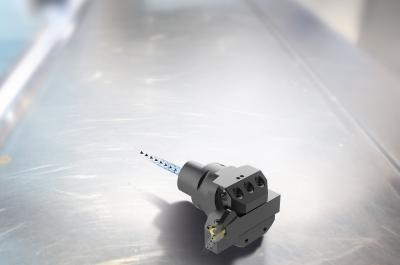
Seco Tools has introduced Jetstream Tooling high-pressure coolant technology for threading shank holders. The new range includes shank holders for external applications, boring bars for internal applications and GL-heads for use with Seco Steadyline boring bars.
The Jetstream Tooling thread turning holders deliver a concentrated high-pressure jet of coolant through a hose connection for up to 275 bar/3,988 psi coolant inlets to the optimum position close to the cutting edge. Unlike flood coolant, high-pressure coolant can penetrate the heat vapor barrier that develops on a cutting tool and workpiece in the cut zone. This Jetstream technology also makes it possible to guide or steer chips away from the cut and increases tool life, even with minimum coolant pressure.
For parts made from titanium or similar materials, Jetstream Tooling technology is capable of breaking the tough threading chips to increase tool life. When threading steel and stainless steel, the improved chip control of the new thread turning tools allow for potentially 30 percent to 60 percent higher cutting speeds without compromising thread surface quality.
Jetstream Tooling thread turning holders are available in 16 external, 28 internal and 14 GL-head types in insert pocket sizes 16, 22 and 27.
Contact Details
Related Glossary Terms
- boring
boring
Enlarging a hole that already has been drilled or cored. Generally, it is an operation of truing the previously drilled hole with a single-point, lathe-type tool. Boring is essentially internal turning, in that usually a single-point cutting tool forms the internal shape. Some tools are available with two cutting edges to balance cutting forces.
- coolant
coolant
Fluid that reduces temperature buildup at the tool/workpiece interface during machining. Normally takes the form of a liquid such as soluble or chemical mixtures (semisynthetic, synthetic) but can be pressurized air or other gas. Because of water’s ability to absorb great quantities of heat, it is widely used as a coolant and vehicle for various cutting compounds, with the water-to-compound ratio varying with the machining task. See cutting fluid; semisynthetic cutting fluid; soluble-oil cutting fluid; synthetic cutting fluid.
- shank
shank
Main body of a tool; the portion of a drill or similar end-held tool that fits into a collet, chuck or similar mounting device.
- threading
threading
Process of both external (e.g., thread milling) and internal (e.g., tapping, thread milling) cutting, turning and rolling of threads into particular material. Standardized specifications are available to determine the desired results of the threading process. Numerous thread-series designations are written for specific applications. Threading often is performed on a lathe. Specifications such as thread height are critical in determining the strength of the threads. The material used is taken into consideration in determining the expected results of any particular application for that threaded piece. In external threading, a calculated depth is required as well as a particular angle to the cut. To perform internal threading, the exact diameter to bore the hole is critical before threading. The threads are distinguished from one another by the amount of tolerance and/or allowance that is specified. See turning.
- turning
turning
Workpiece is held in a chuck, mounted on a face plate or secured between centers and rotated while a cutting tool, normally a single-point tool, is fed into it along its periphery or across its end or face. Takes the form of straight turning (cutting along the periphery of the workpiece); taper turning (creating a taper); step turning (turning different-size diameters on the same work); chamfering (beveling an edge or shoulder); facing (cutting on an end); turning threads (usually external but can be internal); roughing (high-volume metal removal); and finishing (final light cuts). Performed on lathes, turning centers, chucking machines, automatic screw machines and similar machines.

